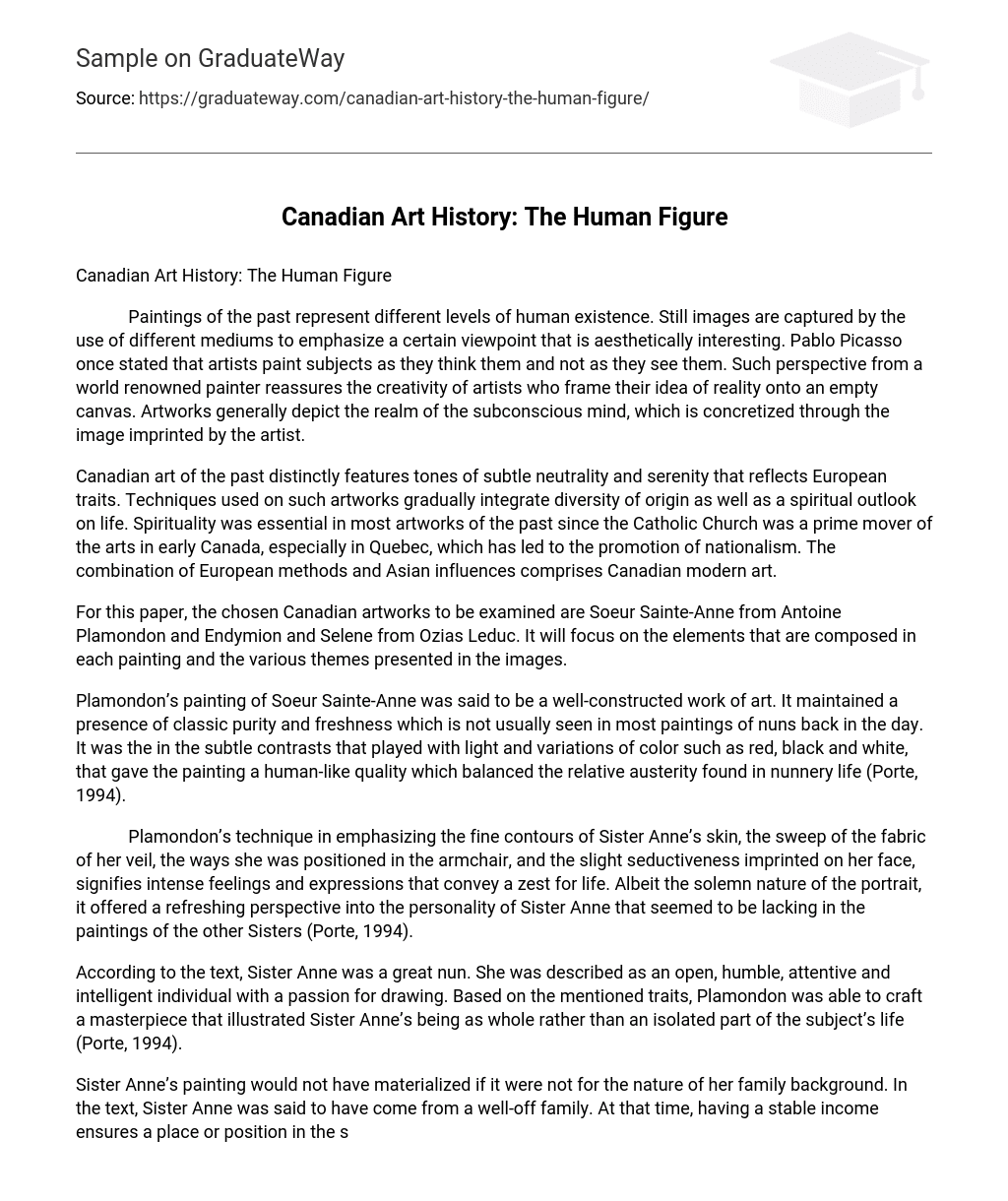Paintings of the past represent different levels of human existence. Still images are captured by the use of different mediums to emphasize a certain viewpoint that is aesthetically interesting. Pablo Picasso once stated that artists paint subjects as they think them and not as they see them. Such perspective from a world renowned painter reassures the creativity of artists who frame their idea of reality onto an empty canvas. Artworks generally depict the realm of the subconscious mind, which is concretized through the image imprinted by the artist.
Canadian art of the past distinctly features tones of subtle neutrality and serenity that reflects European traits. Techniques used on such artworks gradually integrate diversity of origin as well as a spiritual outlook on life. Spirituality was essential in most artworks of the past since the Catholic Church was a prime mover of the arts in early Canada, especially in Quebec, which has led to the promotion of nationalism. The combination of European methods and Asian influences comprises Canadian modern art.
For this paper, the chosen Canadian artworks to be examined are Soeur Sainte-Anne from Antoine Plamondon and Endymion and Selene from Ozias Leduc. It will focus on the elements that are composed in each painting and the various themes presented in the images.
Plamondon’s painting of Soeur Sainte-Anne was said to be a well-constructed work of art. It maintained a presence of classic purity and freshness which is not usually seen in most paintings of nuns back in the day. It was the in the subtle contrasts that played with light and variations of color such as red, black and white, that gave the painting a human-like quality which balanced the relative austerity found in nunnery life (Porte, 1994).
Plamondon’s technique in emphasizing the fine contours of Sister Anne’s skin, the sweep of the fabric of her veil, the ways she was positioned in the armchair, and the slight seductiveness imprinted on her face, signifies intense feelings and expressions that convey a zest for life. Albeit the solemn nature of the portrait, it offered a refreshing perspective into the personality of Sister Anne that seemed to be lacking in the paintings of the other Sisters (Porte, 1994).
According to the text, Sister Anne was a great nun. She was described as an open, humble, attentive and intelligent individual with a passion for drawing. Based on the mentioned traits, Plamondon was able to craft a masterpiece that illustrated Sister Anne’s being as whole rather than an isolated part of the subject’s life (Porte, 1994).
Sister Anne’s painting would not have materialized if it were not for the nature of her family background. In the text, Sister Anne was said to have come from a well-off family. At that time, having a stable income ensures a place or position in the society, which was exactly the case with Sister Anne’s father who was a known butcher in their community. Sister Anne’s father was the one who commissioned Plamondon to create portraits of his daughters, to the delight of Plamondon. Since most artists lived off from whatever artworks that they were able to sell, most of them would only create artworks for the affluent families (Porte, 1994).
With regard to Leduc’s version of the story Endymion and Selene, his work captured the essence of human desire in a distinctly androgynous way. While Plamondon was concerned with the spiritual connection of his subject as a representative of the Catholic Church, Leduc was interested in elevating the spiritual presence of his subjects through the complexities of the human consciousness. The story of the shepherd boy Endymion and the goddess Selene is a tale of forbidden love that stresses on the need for connection and interaction between the two characters despite the differences preceding them. It is a desire that is conveyed through the longing gaze of Selene toward the slumber state of Endymion (Lanthier, 1996).
The painting was said to be highly symbolical of human nature, characterized by the undertones of sexual ambiguity and gentleness. Splashes of pastel colors peppered with asymmetrical constructions of lines and movements imply feminine sexual symbols which convey an idea of perfection and eroticism. The presence of figs and flowers such as laurel, ivy and rose illustrate a desire toward immortality and the cyclical nature of death and rebirth (Lanthier, 1996).
Based on the given descriptions of the two chosen paintings, both artists demonstrated a style that presented the spiritual nature of humanity centered upon two different levels: Religion and Desire. Both paintings expressed the need for spirituality in both moral and social aspects of life.
The differences lie in the techniques applied by the artist and the layers of themes that have been exposed. While Plamondon’s painting was a bit more refined and meticulously composed, Leduc’s work was sketchy and stiff in the delivery of symbolic images and lines, which was also noticed by some critics of his work. Soeur Sainte-Anne depicted the life of a nun that also laid bare the other side of the subject’s human character. Meanwhile, Endymion and Selene exemplified the desire for companionship that moved human frailty on a spiritual level, maintaining a desire to connect just as it was for Sister Anne to connect with the world outside the convent. In essence, both paintings reflect the influence of religion in the furtherance of Canadian art.
References:
Porte, J. R. (1994). Soeur Sainte-Anne 1841 Mano Beland. Antoine Plamondon: Painting in Quebec, 1820-1850. Quebec: Musee du Quebec, 433-435.
Lanthier, M. (1996). Endymion and Selene in Launer Lacroix. Ozias Leduc: an Art of Love and Revene [Quebec] Musee du Quebec, 160-161





